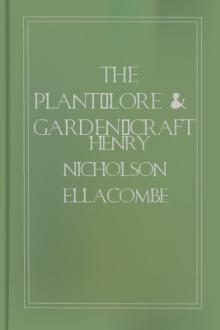The plant-lore & garden-craft of Shakespear, Henry Nicholson Ellacombe [read with me .TXT] 📗

- Author: Henry Nicholson Ellacombe
- Performer: -
Book online «The plant-lore & garden-craft of Shakespear, Henry Nicholson Ellacombe [read with me .TXT] 📗». Author Henry Nicholson Ellacombe
Diffusest honeydrops, refreshing showers. Tempest, act iv, sc. 1 (78). (2) Antipholus of Ephesus. Did this companion with the Saffron face
Revel and feast it at my house to day? Comedy of Errors, act iv, sc. 4 (64). (3) Clown. I must have Saffron to colour the Warden pies. Winter's Tale, act iv, sc. 3 (48). (4) Lafeu. No, no, no, your son was misled with a snipt-taffeta fellow there, whose villanous Saffron would have made all the unbaked and doughy youth of a nation in his colour. All's Well that Ends Well, act iv, sc. 5 (1).
Saffron (from its Arabic name, al zahafaran) was not, in Shakespeare's time, limited to the drug or to the Saffron-bearing Crocus (C. sativus), but it was the general name for all the Croci, and was even extended to the Colchicums, which were called Meadow Saffrons.[268:1] We have no Crocus really a native of Britain, but a few species (C. vernus, C. nudiflorus, C. aureus, and C. biflorus) have been so naturalized in certain parts as to be admitted, though very doubtfully, into the British flora; but the Saffron Crocus can in no way be considered a native, and the history of its introduction into England is very obscure. It is mentioned several times in the Anglo-Saxon Leech Books: "When he bathes, let him smear himself with oil; mingle it with Saffron."—Tenth Century Leech Book, ii. 37. "For dimness of eyes, thus one must heal it: take Celandine one spoonful, and Aloes, and Crocus (Saffron in French)."—Schools of Medicine, tenth century, c. 22. In these instances it may be only the imported drug; but the name occurs in an English Vocabulary among the Nomina herbarum: "Hic Crocus, Ae Safurroun;" and in a Pictorial Vocabulary of the fourteenth century, "Hic Crocus, Ance Safryn;" so that I think the plant must have been in cultivation in England at that time. The usual statement, made by one writer after another, is that it was introduced by Sir Thomas Smith into the neighbourhood of Walden in the time of Edward III., but the original authority for this statement is unknown. The most authentic account is that by Hakluyt in 1582, and though it is rather long, it is worth extracting in full. It occurs in some instructions in "Remembrances for Master S.," who was going into Turkey, giving him hints what to observe in his travels: "Saffron, the best of the universall world, groweth in this realme. . . . It is a spice that is cordiall, and may be used in meats, and that is excellent in dying of yellow silks. This commodity of Saffron groweth fifty miles from Tripoli, in Syria, on an high hyll, called in those parts Gasian, so as there you may learn at that part of Tripoli the value of the pound, the goodnesse of it, and the places of the vent. But it is said that from that hyll there passeth yerely of that commodity fifteen moiles laden, and that those regions notwithstanding lacke sufficiency of that commodity. But if a vent might be found, men would in Essex (about Saffron Walden), and in Cambridgeshire, revive the trade for the benefit of the setting of the poore on worke. So would they do in Herefordshire by Wales, where the best of all England is, in which place the soil yields the wilde Saffron commonly, which showeth the natural inclination of the same soile to the bearing of the right Saffron, if the soile be manured and that way employed. . . It is reported at Saffron Walden that a pilgrim, proposing to do good to his countrey, stole a head of Saffron, and hid the same in his Palmer's staffe, which he had made hollow before of purpose, and so he brought the root into this realme with venture of his life, for if he had bene taken, by the law of the countrey from whence it came, he had died for the fact."—English Voiages, &c., vol. ii. From this account it seems clear that even in Hakluyt's time Saffron had been so long introduced that the history of its introduction was lost; and I think it very probable that, as was suggested by Coles in his "Adam in Eden" (1657), we are indebted to the Romans for this, as for so many of our useful plants. But it is not a Roman or Italian plant. Spenser wrote of it as—
and Browne—
which information they derived from Pliny. It is supposed to be a native of Asia Minor, but so altered by long cultivation that it never produces seed either in England or in other parts of Europe.[270:2] This fact led M. Chappellier, of Paris, who has for many years studied the history of the plant, to the belief that it was a hybrid; but finding that when fertilized with the pollen of a Crocus found wild in Greece, and known as C. sativus var. Græcus (Orphanidis), it produces seed abundantly, he concludes that it is a variety of that species, which it very much resembles, but altered and rendered sterile by cultivation. It is not now much cultivated in England, but we have abundant authority from Tusser, Gerard, Parkinson, Camden, and many other writers, that it was largely cultivated before and after Shakespeare's time, and that the quality of the English Saffron was very superior.[271:1] The importance of the crop is shown by its giving its name to Saffron Walden in Essex,[271:2] and to Saffron Hill in London, which "was formerly a part of Ely Gardens" (of which we shall hear again when we come to speak of Strawberries), "and derives its name from the crops of Saffron which it bore."—Cunningham. The plant has in the same way given its name to Zaffarano, a village in Sicily, near Mount Etna, and to Zafaranboly, "ville située près Inobole en Anatolie, au sud-est de l'ancienne Héraclée."—Chappellier. The plant is largely cultivated in many parts of Europe, but the chief centres of cultivation are in the arrondissement of Pithiviers in France, and the province of Arragon in Spain; and the chief consumers are the Germans. It has also been largely cultivated in China for a great many years, and the bulbs now imported from China are found to be, in many points, superior to the European—"l'invasion Tartare aurait porté le Safran en Chine, et de leur côté les croisés l'auraient importé en Europe."—Chappellier.
I need scarcely say that the parts of the plant that produce the Saffron are the sweet-scented stigmata, the "Crocei odores" of Virgil; but the use of Saffron has now so gone out of fashion, that it may be well to say something of its uses in the time of Shakespeare, as a medicine, a dye, and a confection. On all three points its virtues were so many that there is a complete literature on Crocus. I need not name all the books on the subject, but the title page of one (a duodecimo of nearly three hundred pages) may be quoted as an example: "Crocologia seu curiosa Croci Regis Vegetabilium enucleatio continens Illius etymologiam, differencias, tempus quo viret et floret, culturam, collectionem, usum mechanicum, Pharmaceuticum, Chemico medicum, omnibus pene humani corporis partibus destinatum additis diversis observationibus et questionibus Crocum concernentibus ad normam et formam S. R. I. Academiæ Naturæ curiosorum congesta a Dan: Ferdinando Hertodt, Phys. et Med. Doc., &c., &c. Jenæ. 1671." After this we may content ourselves with Gerard's summary of its virtues: "The moderate use of it is good for the head, and maketh sences more quicke and lively, shaketh off heavy and drowsie sleep and maketh a man mery." For its use in confections this will suffice from the "Apparatus Plantarum" of Laurembergius, 1632: "In re familiari vix ullus est telluris habitatus angulus ubi non sit Croci quotodiana usurpatio, aspersi vel incocti cibis." And as to its uses as a dye, its penetrating powers were proverbial, of which Luther's Sermons will supply an instance: "As the Saffron bag that hath bene ful of Saffron, or hath had Saffron in it, doth ever after savour and smel of the swete Saffron that it contayneth; so our blessed Ladye which conceived and bare Christe in her wombe, dyd ever after resemble the maners and vertues of that precious babe which she bare" ("Fourth Sermon," 1548). One of the uses to which Saffron was applied in the Middle Ages was for the manufacture of the beautiful gold colour used in the illumination of missals, &c., where the actual gold was not used. This is the recipe from the work of Theophilus in the eleventh century: "If ye wish to decorate your work in some manner take tin pure and finely scraped; melt it and wash it like gold, and apply it with the same glue upon letters or other places which you wish to ornament with gold or silver; and when you have polished it with a tooth, take Saffron with which silk is colored, moistening it with clear of egg without water, and when it has stood a night, on the following day cover with a pencil the places which you wish to gild, the rest holding the place of silver" (Book i, c. 23, Hendrie's translation).
Though the chief fame of the Saffron Crocus is as a field plant, yet it is also a very handsome flower; but it is a most capricious one, which may account for the area of cultivation being so limited. In some places it entirely refuses to flower, as it does in my own garden, where I have cultivated it for many years but never saw a flower, while in a neighbour's garden, under apparently the very same conditions of soil and climate, it flowers every autumn. But if we cannot succeed with the Saffron Crocus, there are many other Croci which were known in the time of Shakespeare, and grown not "for any other use than in regard of their beautiful flowers of several varieties, as they have been carefully sought out and preserved by divers to furnish a garden of dainty curiosity." Gerard had in his garden only six species; Parkinson had or described thirty-one different sorts, and after his time new kinds were not so much sought after till Dean Herbert collected and studied them. His monograph of the Crocus, in 1847, contained the account of forty-one species, besides many varieties. The latest arrangement of the family by Mr. George Maw, of Broseley, contains sixty-eight species, besides varieties; of these all are not yet in cultivation, but every year sees some fresh addition to the number, chiefly by the unwearied exertions in finding them in their native habitats, and the liberal distribution of them when found, of Mr. Maw, to whom all the lovers of the Crocus are deeply indebted. And the Croci are so beautiful that we cannot have too many of them; they are, for the most part, perfectly hardy, though some few require a little protection in winter; they are of an infinite variety of colour, and some flower in the spring and some in the autumn. Most of us call the Crocus a spring flower, yet there are more autumnal than vernal species, but it is as a spring flower that we most value it. The common yellow Crocus is almost as much "the first-born of the year's delight" as the Snowdrop. No one can tell its native country, but it has been the brightest ornament of our gardens, not only in spring, but even in winter, for many years. It was probably first introduced during Shakespeare's life. "It hath floures," says Gerard, "of a





Comments (0)